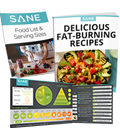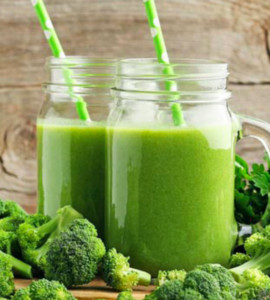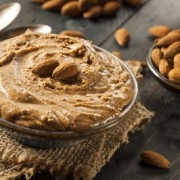Bottom Line: A Calorie is NOT A Calorie In Real Life

A Calorie is NOT A Calorie Big Ideas
-
A Calorie is Not a Calorie
“Attacking the obesity epidemic will involve giving up many old ideas that have not been productive. ‘A calorie is a calorie’ might be a good place to start.” – R.D. Feinman, State University of New York
Beyond battling our basic biology, calorie balancing is bound to fail us because a calorie is not a calorie. The difference in calorie quality is really important. That’s because the quality of the calories we eat influences our hormones. Those in turn determine our set-point. We can control our weight, just not the way you have been led to believe.
The Calories In – Calories Out theory of weight control depends on the assumption that our bodies work like balance scales. Balance scales do not measure quality. On a balance scale, a pound of feathers weighs the same as a pound of lead. Quality is irrelevant. So on a balance scale, 300 calories of vegetables is the same as 300 calories of pasta. The only problem is that the body is not a balance scale.
Let’s look at the issue another way. Breathing in smoke-filled air for thirty years does something different to our respiratory system than breathing in the same quantity of fresh air. In the same fashion, putting 2,000 calories of low-quality food into our fat metabolism system does something different than putting in the same quantity of high-quality food. Quality counts. Our bodies do not work like balance scales.
-
Introducing the SANE Solution
The quality of calories depends on four fascinating factors:
1. Satiety – How quickly calories fill us up and how long they keep us full
2. Aggression – How likely calories are to be stored as body fat
3. Nutrition – How many nutrients—aka protein, vitamins, minerals, etc.—calories provide
4. Efficiency – How many calories can be stored as body fat -
SANE vs. inSANE
The more Satisfying, unAggressive, Nutritious, and inEfficienct a calorie is, the higher its quality. The more SANE it is. The more body-fat-burning hormones it triggers. The more it unclogs our metabolism and prevents overeating.
The more unSatisfying, Aggressive, not Nutritious, and Efficient a calorie is, the lower its quality. The more inSANE it is. The more body-fat-storing hormones it triggers. The more it clogs our metabolism and encourages overeating.
-
It’s SANE to Eat Large Amounts of the Right Food
The more we understand the four calorie-quality factors, the more clearly we will see how eating more high-quality SANE food is the only practical way to burn body fat long term. When you stay full of SANE food, you will not have any room for clog-causing inSANE calories. When we are totally full from a super-sized SANE supper, skipping the sundae after isn’t a burden. It’s a blessing in disguise. By staying full of SANE calories, we clear our clog, drop our set-point, and enable our fat metabolism system to burn body fat for us automatically.
“…for the vast majority of people, being overweight is not caused by how much they eat but by what they eat. The idea that people get heavy because they consume a high volume of food is a myth. Eating large amounts of the right food is your key to success…” – Joel Fuhrman, Doctor and Author
Sound too good to be true?
-
It’s InSANE to Claim “A Calorie is a Calorie”
Whether a calorie is high-quality or low-quality depends on where it fits on the SANEity spectrum.
High-quality calories are on the healthy end of the SANEity spectrum. They areSatisfying, unAggressive, Nutritious, and inEfficient. They fill us up quickly and keep us full for a long time. They provide a lot of nutrients, and few of them can be converted into body fat. Even better, they trigger the release of body-fat-burning hormones, clear clogs, and lower our set-point. In short, they are SANE.
Low-quality calories are just the opposite. They are on the unhealthy end of the SANEity spectrum. They are unSatisfying, Aggressive, non-Nutritious, andEfficient. They trigger the release of body-fat-storing hormones, cause clogs, and raise our set-point. In short, they are inSANE.
-
Eat SANE and Lose Fat
In all of the studies that follow, everyone ate the exact same quantity of calories, but one group’s calories were of much higher quality (were much more SANE) than the other groups’:
- University of Florida researcher J.W. Krieger analyzed eighty-seven studies and found that those people who ate SANE calories lost an average of twelve more pounds of body fat compared to those who ate an equal quantity of inSANE calories.
- C.M. Young at Cornell University split people into three groups, each eating 1,800 calories per day, but at different levels of SANEity. The most SANE group lost 86.5% more body fat than the least SANE group.
- In the Annals of Internal Medicine, F.L. Benoît compared a reduced-calorie inSANE diet to a reduced-calorie SANE diet. After ten days the SANE diet burned twice as much body fat.
- Additional studies by researchers U. Rabast (1978,1981), P. Greene (2003), N.H. Baba (1999), A. Golay (1996), M.E. Lean (1997), C.M. Young (1971), and D.K. Layman (2003) all show that people who ate SANE calories lost an average of 22% more weight than those who ate the exact same quantity of inSANE calories.
-
Calories Aren’t All that Matter… Ask Anyone Taking Insulin
“Insulin has profound metabolic effects in the determination of body weight…” – B. Dokken, University of Arizona
The critical effect hormones have on body fat has been well known in scientific circles for a long time. Especially the hormone insulin. Three quick examples:
- A study in the journal Diabetic Medicine found that giving patients the hormone insulin “is associated with weight gain,” specifically, “an increase in trunk [belly] fat mass.
- The journal Diabetes and Metabolism reports: “Most studies report an average 13.2 lb. weight gain during the first year following the initiation of insulin therapy.” The journal went on to conclude that when it comes to taking shots of the hormone insulin “weight gain seems mandatory.”
- In the journal Diabetes an aptly title study “Intensive Insulin Therapy and Weight Gain in IDDM (type 1 diabetes)” revealed that after only two months, “Body weight increased ~6 lbs. with intensive insulin therapy as a result of an increase in fat mass.”
-
But Are You Exercising Enough?
Note that there’s no mention of “eating too much” or “exercising too little.” That’s because calories aren’t all that matter. Hormones matter a lot. Hundreds of millions of diabetics have proven this for years. And that’s why long-term fat loss and robust health isn’t about eating less of a hormonally-poor traditional diet and doing more hormonally-irrelevant traditional exercise. These techniques may mask our hormonal breakdown, but they do not fix it. -
Forget It
Forget counting calories. Long-term fat loss and robust health isn’t about eating less of a hormonally-poor traditional diet and doing more hormonally-irrelevant traditional exercise. -
Remember It
Focus on eating more hormonally-helpful SANE foods, and doing less, but hormonally-helpful eccentric exercise. Eat more and exercising less–smarter. Sure that seems like the opposite of what we’ve been told to do, but isn’t it about time to get the opposite of what we’ve gotten?










